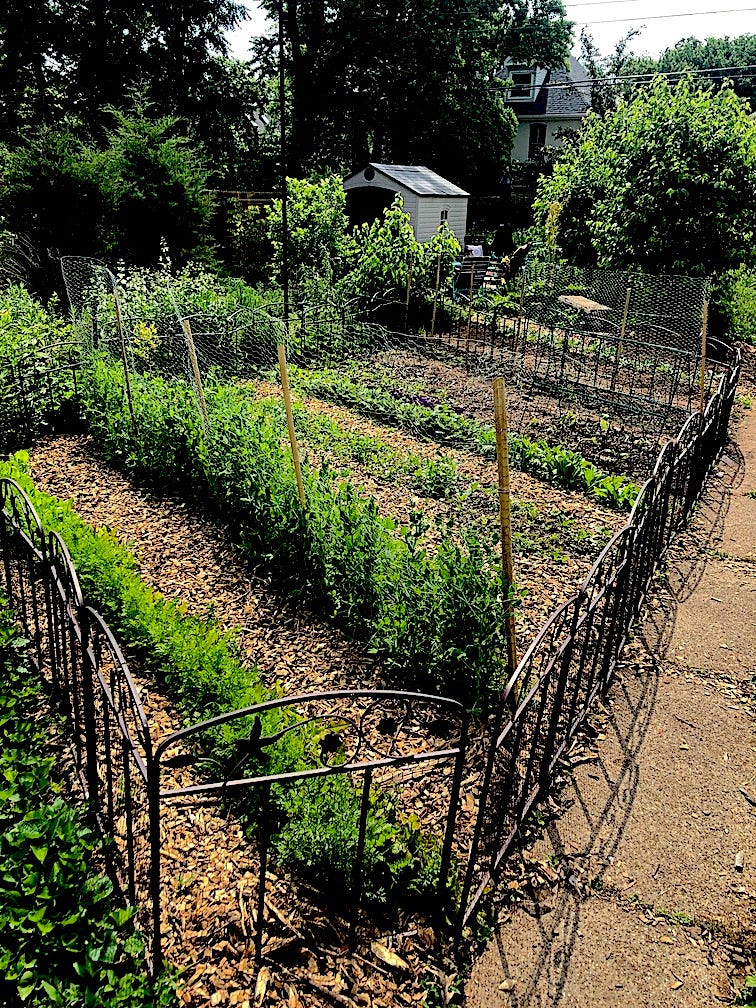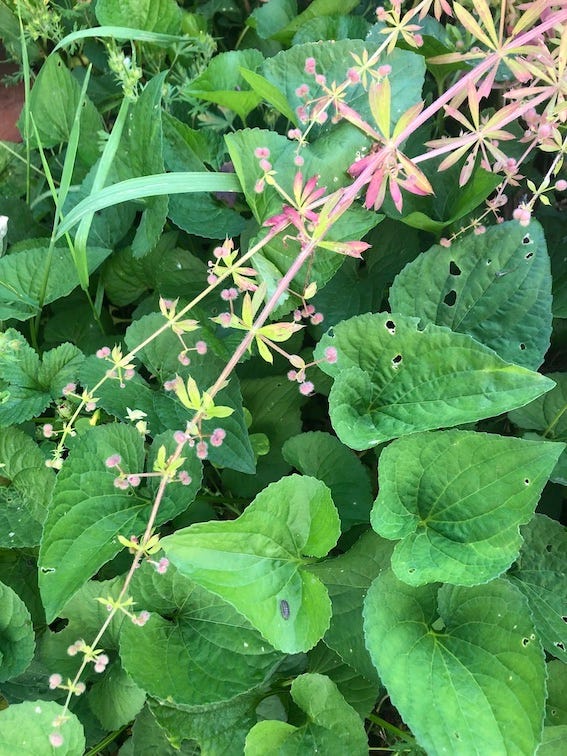Standing tall in the summer garden
It's never what you expect or plan for, but this time it's full of food for all.
As we officially welcome summer this week, I thought we owed you an update on where things stand in the garden.
And that’s tall. They stand, tall, especially all those asters!
I planted one little purple aster (Symphyotrichum novae-angliae, to be precise) a few years ago, and we now have a garden full of them. Half are those purple beauties, and the other half are white old field asters (Symphyotrichum pilosum), which arrived here of their own accord and take no direction from us.
I’m not complaining. We love asters, and so do the bees.
Speaking of bees, I’ve signed on to conduct bee surveys in our garden for a fourth year in the Shutterbee program. The researchers running that outfit recently shared some exciting findings, and I’ll write those up soon.
As I mentioned in the spring update above, natives form the infrastructure which not only helps ameliorate the effects of habitat loss but also supports our annual food garden. The natives are coming into maturity this year, with a few standouts.
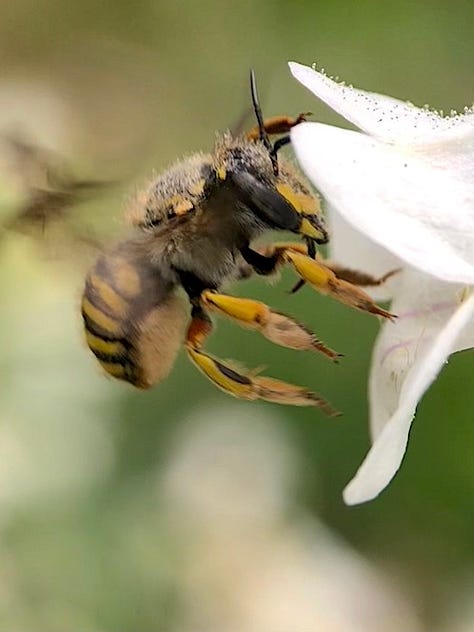
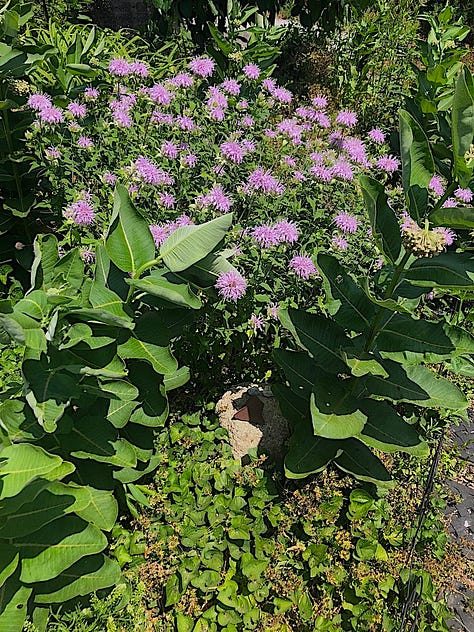
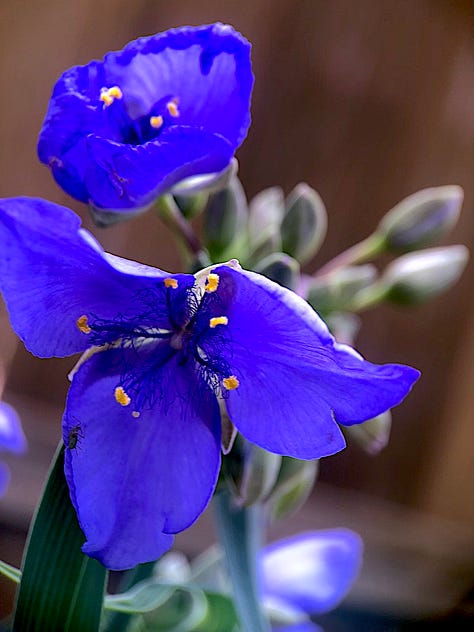
Besides asters, which do a great job of feeding late-season pollinators when they bloom in August, we’re growing an enthusiastic patch of foxglove beardtongue, a thriving bed of meadow anemone, spreading pockets of rattlesnake master and spiderwort, a wheelbarrow full of bloomin’ prickly pear, and bee balm to beat the band.
We’ve been eating out of the garden since early April, when we harvested lilacs and violets and used them for jam, tea, and syrup.
We’ve also regularly pulled volunteer chickweed, henbit dead nettle, and cleavers out of our yard and made pesto out of them, as I posted about here in Notes. De-lish! You can make pesto out of just about any green, the same way you do with basil. Just swap out basil for dandelion greens or what-have-you, and adjust the other ingredients in your food processor (olive oil, parmesan cheese, nuts or seeds, lemon juice, and garlic) to taste as you go. Speaking of the so-called “weed” known as cleavers, aka cockleburs, check out this detailed post from
, which speaks to the medicinal value of this misunderstood plant.Instead of sending cleavers to the compost next spring, pull them when they’re nice and green and make pesto or tea, or just use them in a smoothie or to flavor your pitcher water. We don’t even bother to rid the garden of these beauts, as they turn a pretty russet red before fading away in short order.
So those are the easy native and freebie plants, for which you don’t have to work much to enjoy. We also reap the benefit of having sown perennials like asparagus and the herbs mint, lemon balm, oregano, and marjoram, all of which are flavoring our plates.
Then there are the annual food plants, and I think this will be our biggest, most successful plot yet—after years of copious trial and error.
We’ve been eating salad nearly every day, thanks to two highly reliable lettuce varieties from Southern Exposure Seed Exchange, ‘Bronze arrow’ looseleaf and ‘Jericho’ romaine. We’re also growing robust rows of ‘Red Russian’ kale and ‘Ruby red’ Swiss chard. And of course, we foraged for serviceberries, as our young trees don’t yet have much fruit. We’ve also begun to harvest carrots, peas, gooseberries, and sand cherries, and we let visitors taste-test gooseberries during the Sustainable Backyard Tour.
Soon to harvest: cabbage and potatoes. As you’ve read previously, we’ve had some peculiar problems with potatoes, but we’re trying a new variety—Burpee’s Rio Grande russet—that is supposed to be idiot-proof (yours truly being the idiots), and they look promising so far.
Remember our sad greenhouse story?
Well, I tried growing starts in an upstairs room with a southern exposure and a door I could close to keep Chaco from digging up the seedlings. The window isn’t big enough, however, so the starts were spindly and weak. When I transplanted them, all but one of the ‘Amish paste’ tomatoes and one marigold, as well as some of the basil and cucumbers died.
I’ve since learned that cucumbers don’t transplant well anyway. I’ve supplemented with basil, ‘White spine’ cucumber seeds from local chain Menard’s, and a tray of ‘Brandywine pink’ tomato starts from our neighborhood garden center.
All of these warm-season transplants went into a bed that had been prepared ahead of time by our chickens.
I need to take a moment here to let you know that all five of our little bird girls have since gone to meet their maker, are kaput, have left this earthly plane.
I’ll write about this more when I can talk about it without getting blubbery, as I know these are “livestock” and not pets, believe me, and I’m working on toughening up, BUT.
For now I’ll just say that the chickens did their job: They ate down the weeds, tilled the soil by scratching, and fertilized it. Then we broadforked the plot, turning it over and prepping it for what I believe is going to be a very lush offering of warm-season veg. The seedlings are joined by direct-sown zucchini, summer squash, and peppers, and most have already germinated well.
Paying subscribers can check out how plans got changed and fleshed out as recorded in my garden log spreadsheet after the paywall below. The rest of you will have to imagine the glory of a multi-tab, color-coded spreadsheet…
My blessings to you for a fruitful, happy, healthy garden. May you be thick with tomatoes and find ladybugs everywhere, even in your hair.
Keep reading with a 7-day free trial
Subscribe to Brunette Gardens to keep reading this post and get 7 days of free access to the full post archives.



